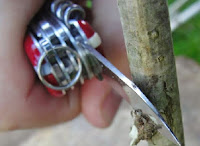Now pine cones are arguably nature's cross between a feather stick and kindling, it's just getting them going that's the trick because they are actually pretty good short term fuel. The above picture is from a few years ago of a kelly kettle powered by cones that was keeping me supplied with tea as I painted the fence.
Not so long ago I was involved with helping produce The Outdoor Adventure Manual, a book which was a joint venture between The Scout Association and Haynes Publishers. In the fire section is a piece on Baskerville burners, which are effectively pimped up cones for use in fire lighting invented at Tolmers Scout camp. They also make an appearance on a Victorinox fact sheet (that I also helped with) that supported the Scout Survival Skills badge. As well as being pretty effective they are simple, and rather good fun to make.
There are three things you'll need to make a burner; Obviously you'll need a pine cone (and things are made much easier if the scales are slightly open), some thin dry twigs of straight shavings and papery silver birch bark, I've used Himalayian silver birch bark for this one, the super peely ones that you find in towns.
Now take the thin twigs or shavings and find three or four that are approximately the same length. I've used some wood shavings that I saved from a bowdrill session a while ago.
These need inserting evenly about a third of the way from the base of the cone and they should be a few centimetres taller than the cone's base. again you may have to force the wood in if the cone isn't that open.
Next stuff some of the bark into the gaps between the cone scales and leave the pieces sticking out, these only really need to be in the gaps near the cone's apex. This will obviously be a little harder if the cone isn't very open. You can also try stuffing it then putting the legs in but it can be a bit tight if the ideal gap for one is filled with bark.
And now this 'Little Sputnik' is now ready to light. A trailing piece of bark at the base (the cones former apex) is ideal to start it off with a match. The original also suggests putting some fine kindling underneath as well, but this example is rammed with birch bark so I didn't bother.
The featherstick like shape of the cone soon helps it catch as the flammable birch bark burns. If the cone is more shut than you'd like it does take a little while longer to fully ignite and you can feather the edge of the legs to help. You can just see that one of the legs is starting to burn which will make it fall over, extra legs can help but with the cone alight it still does it's job. I still prefer using something like matchstick thin twigs as a kindling with silver birch, but these 'burners' are an enjoyable alternative.
And finally, here's a retro-recorded Youtube video on how to make one.

